Four Options To Transform Brady Street
Business improvement district releases study, seeks feedback. The goal: 'to create one of the world's great streets.'
After months of blue-sky discussion about how it might work, Brady Street businesses and residents now have a formal study of options for overhauling the Lower East Side main street to consider.
Four options, created by a consulting partnership of GRAEF and The Kubala Washatko Architects (TKWA), detail different options to give the street a “pedestrian-first” approach.
The four options, prepared for the area between N. Humboldt Avenue and N. Farwell Avenue, consider everything from redesigning the street to discourage or prevent speeding to closing it to virtually all vehicles. All of the options preserve some level of vehicle access.
“I am thrilled to release this report,” said Rachel Taylor, executive director of the Brady Street Business Improvement District, in a statement. “This is a pivotal moment in our collective pursuit of a better Brady Street. The study showcases the careful research, analysis, and dedication of our team. We will continue to work hand-in-hand with local businesses, residents, and organizations to shape this cherished community.”
Area Alderman Jonathan Brostoff will host the first community meeting on the proposal on Tuesday, June 27 from 5:30 p.m. to 7 p.m. at St. Hedwig Church, 1702 N. Humboldt Ave.
“Brady Street is a bustling and vibrant area, and it is essential we make our streets safe for all people,” said Brostoff. “We are proud to have collaborated with experts to develop a study that will increase safety for our community.”
In a Public Works Committee meeting earlier this month, the alderman said it was a matter of when, not if there would be changes. But now the public can react to what those changes might be.
Four concepts were explored: enhanced intersections with raised pavement, an enhanced corridor with speed tables and a curbless design intended to reduce driving speeds, a limited-access plan between N. Warren Street and N. Arlington Place and an extended limit-access plan between N. Farwell Avenue and N. Humboldt Avenue.
“The study imagines a transformed Brady Street, a place filled with people comfortably and safely enjoying one of Milwaukee’s great neighborhoods” said Craig Huebner, planning and urban design practice leader for GRAEF.
“Our team was driven by a singular goal: create one of the world’s great streets,” said TKWA partner Chris Socha.
The design alternatives include suggestions on possible implementation options for each ranging from interim trials to permanent pavement changes.
The BID will continue to solicit feedback from area businesses, residents and stakeholders in the coming months. Following a summer engagement period, the BID anticipates working with city officials on a final design. Comments can be submitted on the BID website.
Option 1 – Slow & Safe: Enhanced Intersections
The first option considered would allow full vehicle access to remain, but speed tables (elevated pavement similar to speed hump) at three intersections would reduce speeds and place pedestrians and vehicles on the same level. There would be minimal impact to on-street parking. Drivers are expected to develop a habit of diverting around the corridor by using N. Humboldt Avenue, N. Farwell Ave. and E. Ogden Avenue.
A short-term test could be instituted with paint or pinned-on curb bumpouts at the intersections.
Option 2 – Slow & Safe: Enhanced Corridor
The enhanced corridor option would build on the intersection speed tables by converting the entire-four block corridor into a raised, curbless area where vehicles and pedestrians are at the same level. The design would give the corridor a plaza-like feel, particularly at intersections. Up to 50% of on-street parking would be removed for pedestrian bump-out options.
Option 3 – People Only: Enhanced Corridor
The first “people only” option limits access to a two-block stretch, making it only for pedestrians, bicyclists, buses, emergency vehicles and delivery vehicles.
The proposal is targeted for the “core” of the street, the area between N. Warren Avenue and N. Franklin Place with an extension north on N. Arlington Place. But that comes with a risk in that unaware drivers would detour on the side streets instead of using main streets like Humboldt, Farwell or Ogden.
The resulting street, if rebuilt, would be much narrower at 20 feet wide allowing for dramatically expanded sidewalks in what is currently a 66-foot-wide right-of-way.
A permanent solution would need to be implemented to block or substantially deter unauthorized vehicles, with several options presented. Temporary signage and barriers could be used on an interim basis.
Option 4 – People Only: Hilltop to Lakefront
The final option would expand the “people only” design to four blocks, extending from Humboldt to Farwell. N. Franklin Place would be maintained as an area where vehicles could cross north-south.
The design is likely to reduce traffic on neighborhood side streets compared to the shorter “people only” design because it starts at major streets.
A full copy of the study is available on Urban Milwaukee.
Design Drawings
If you think stories like this are important, become a member of Urban Milwaukee and help support real, independent journalism. Plus you get some cool added benefits.
Transportation
-
Congestion Pricing Cuts Air Pollution in New York City
 Dec 14th, 2025 by Jeff Wood
Dec 14th, 2025 by Jeff Wood
-
FTA Tells Milwaukee to Crack Down on Fare Evasion — Even Where Fares Don’t Exist
 Dec 12th, 2025 by Graham Kilmer
Dec 12th, 2025 by Graham Kilmer
-
Will GOGO’s Bus Service Ever Get Going?
 Dec 9th, 2025 by Jeramey Jannene
Dec 9th, 2025 by Jeramey Jannene


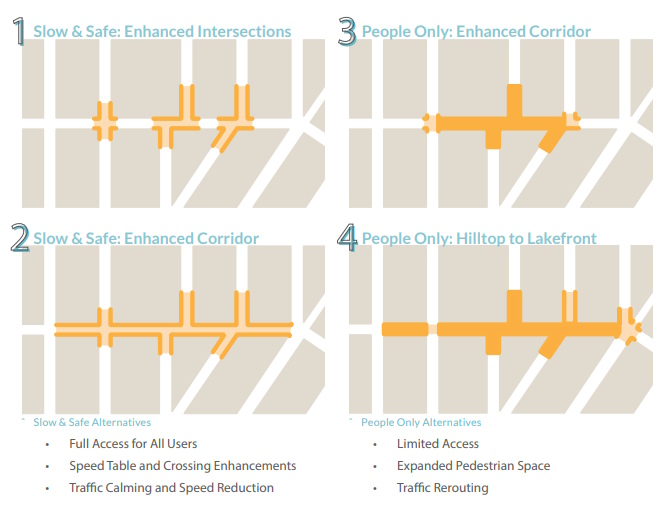
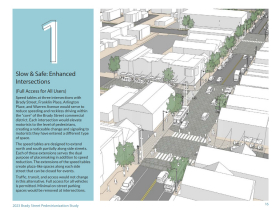
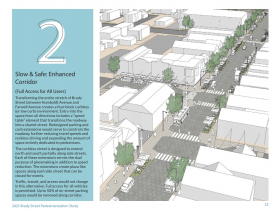
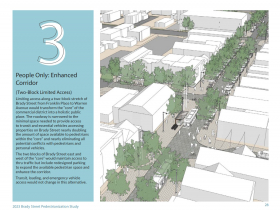
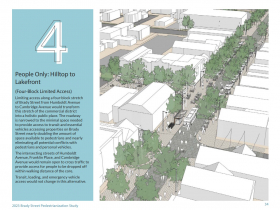
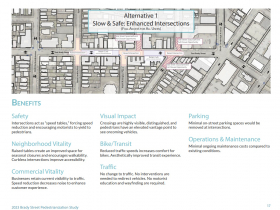
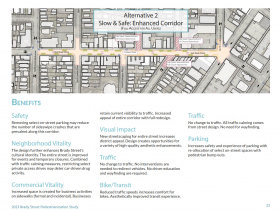
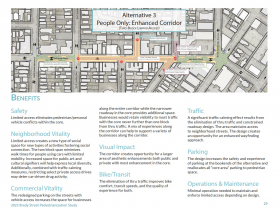
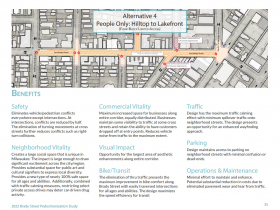

















Option 4 should be the preferred option. Pair that with some increased residential density and mixes of uses on Brady (ie please pivot away from bars above all else policy).
I agree completely with what Johnstanbul stated.
Has there been any discussion of closing off a section to private vehicles, but still allowing buses? And maybe delivery vehicles? Similar to State Street in Madison, but with more space dedicated to pedestrians.
Personally, I favor option three or four. Getting people out of their cars and on foot will increase commerce on Brady as well as drastically reducing pedestrian injuries and deaths.
However, adoption of ANY of these four options is far better than the status quo.
As the gentleman said during at the meeting, if you construct a neighborhood to primarily accommodate cars, you will get cars. If you construct a neighborhood to accommodate pedestrians, you will get pedestrians. I vote for pedestrians.
Any of these are an improvement over what we have now, but YES, option 4 is where it’s at, love it. Wish it went on for more of Brady (but if that can’t be done, at least do an option 1 for remainder of Brady too?).
No. 4 looks the best of the choices. But Humboldt? Why not Van Buren? If they do this, Humboldt to Van Buren will remain a nightmare and only worsen over time. I would guess when Brady Street was created in its current form from Van Buren to Farwell, it had 33% of the population within a mile that it has now. Probably 75% of what it has now only 15 years ago. It is simply too small for that many people. Good luck with it.